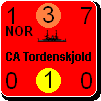Anthropoid
Posts: 3107
Joined: 2/22/2005
From: Secret Underground Lair
Status: offline

|
Since we had the discussion of attrition (in which I complained about the attrition of land soldiers but nothing else in the game suffering it) I have wanted to have a look about crew sizes, and the effect of crew quality. Reason is, someone stated that (a) crew sizes for navies of the time would be piddly small and don't need to be represented; (b) replacements could just come from impressed vagabonds at port.
A crew with 30% vagabonds would not do so well as one with 5%, and in support of this claim, a wiki quote
http://en.wikipedia.org/wiki/Ship_of_the_line
quote:
British crews excelled, in part, because they spent much more time at sea, were generally better fed, were well trained in gunnery (allowing a faster rate of fire), and were generally more competent, as the Royal Navy based promotion much more on merit rather than purchase.
I am no expert of this period, so I am limited in the facts I can quote. But here is something I found very quickly here on the Ship of the Line page on Wiki
quote:
Mary Rose was an English carrack and one of the first to be able to fire a full broadside of cannons, being well equipped with 78 guns (91 after a 1536 upgrade). Built in Portsmouth, England (1509–1510) she is thought to have been named after King Henry VIII's sister Mary and the rose, the Tudor emblem. She was one of the earliest purpose-built warships to serve in the English Navy; it is thought that she never served as a merchant ship. She displaced 500 tons (700 tons after 1536), was 126 feet (38.5 m) long and 38 feet (11.7 m) abeam, and her crew consisted of 200 sailors, 185 soldiers, and 30 gunners. Although she was the pride of the English fleet she was accidentally capsized during an engagement with the French on 19 July, 1545.
So in 1545, the pride of the English Navy had a crew of 415. The game is set in late 1700s. I will assume, since bigger with more guns was the prevailing theme in the evolution of warship in the era, that crews of 500 perhaps even 750 existed by the 1790s?
As an example, the Rusian navy at start of 1792 scenario has 12 Frigates (*200 crew??), 30 3rd Raters (*500 crew?) and 8 1st Raters (* 600 crew?). Using these ballpark guesstimates of crew sizes, this works out to be 22,200 sailors, gunner, marines and officers. While granted this is a much smaller number than an army of 100K or an entire land force of 100,000, it is substantially more than the minimum land unit size (militia) which DO suffer attrition.
I think the logistical/strategic part of the naval part of the game could do with a bit more detail. Ships should be limited/facilitated in some way by proximity to supply sources. They should also under certain circumstances suffer attrition of their crews. If March attrition is going to be one of the factors differentiating "difficulty" level, then it should apply also to naval units. One might even consider that it should apply to populations suffering losses as a result of plundering, housing foraging armies, or during sieges.
_____________________________
|
 Printable Version
Printable Version








 Soldiers getting out of breath from marching too long and having heart attacks?
Soldiers getting out of breath from marching too long and having heart attacks? 


 New Messages
New Messages No New Messages
No New Messages Hot Topic w/ New Messages
Hot Topic w/ New Messages Hot Topic w/o New Messages
Hot Topic w/o New Messages Locked w/ New Messages
Locked w/ New Messages Locked w/o New Messages
Locked w/o New Messages Post New Thread
Post New Thread